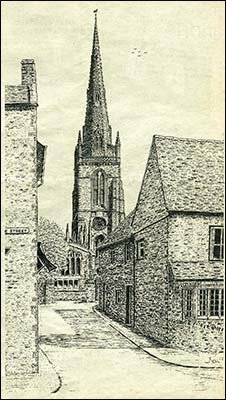 |
|
Magnificent . . . the crocketed steeple
of the church of St Mary
|
The ancient town of Higham Ferrers, situated on the A6, adjoining the town of Rushden, has a long and eventful history for along with its compact collection of attractive medieval buildings clustered around the Market Square is a conservation area that any tourist shouldn’t miss at any price.
Alongside Towcester it is arguably the oldest town in Northamptonshire and still manages to retain much of its old world appearance, following an extensive facelift in recent years.
Numerous relics of the Roman era have been found in the area and its pleasant position, high above the River Nene, is where the Saxons and Normans built their settlements in later years.
Indeed that is how its name originates, for it was known as Hecham, an important town of the time of the Domesday Book survey. It means high homestead, overlooking the river valley.
The distinctive name Ferrers was added at a later date to commemorate one of the most ancient families of the land the de Ferrers, whose descendants can still be traced today.
Shortly after the Norman Conquest, a baronial castle was erected by the Pereval [sic] family just north of the church and later the manor of Higham was given to Henry De Ferrers for his loyal service to king and country.
It was one of several English manors given to this historic personage of rank, the majority of them being in Derbyshire, but it was William de Ferrers, the sixth Earl of Derby, who gave his name to Higham during the reign of King John.
He took an active interest in developing the area which became a thriving little market town but in the years to follow, Robert, the eighth and last Earl of Derby was one of the leaders in the struggle against Henry III which resulted in a crushing defeat at Evesham.
His unyielding attitude meant that he was excluded from the amnesty known as the Dictum of Kenilworth, and following several years of imprisonment was deprived of his earldom and his estates were disposed of.
They were bestowed by the king on his younger son, Edmund Crouchback, the Earl Lancaster. From this point on a Plantagenet and not a Ferrers became lord of Higham but the place name remained.
It was about this time that the building of the beautiful church of St Mary had commenced, which is one of the five great crocketed spires of Northamptonshire the others being at nearby Rushden, Kettering, Oundle, and Kings Sutton.
The building of the church was spread over a long period of time. The southern half together with the tower was constructed in the Thirteenth Century and the northern half and the spire in the next century.
Built on the scale of a small cathedral, it is certainly one of the grandest parish churches in the whole county, its magnificent crocketed steeple, with a perforated parapet flanked by flying buttresses, dwarfing the many fine old buildings grouped around the Market Square.
It reaches a height of 170 feet and is full of interest, both externally and internally among its many architectural features being a remarkable tomb which has been admired by archaeologists from all over the world for its beauty and splendid decorative quality of the canopy above it.
No-one knows for sure for whom the tomb was built, but it is believed to have been for a member of the royal house of England and in each of the four panels at either side is a shield with arms one shield on each side bearing the arms of the Lancasters.
The interior is very spacious and impressive, with three parallel arcades and four gangways (aisles), many beautiful, stained glass windows and some of the finest brasses in the county.
Approaching the church from College Street you pass by the former schoolhouse which adjoins the north-west corner and immediately you are confronted by the west doorway and the superb craftsmanship above it.
Here you see ten decorative medallions which depict scenes from the life of Christ, which are exceedingly beautiful, and when you have spent some time looking at the skills of the past you can cross the churchyard to the south side and take a look at Bede House.
This lovely old building, together with the former schoolhouse were set up as charitable institutions by the Fifteenth Century archbishop Henry Chichele, who, as the patron saint of Higham is remembered as a benefactor of the poor and aged in the town.
We will be hearing more of him next week, together with the splendid memorials he left to his native town.